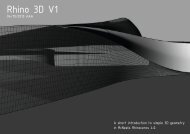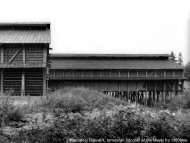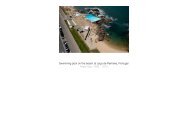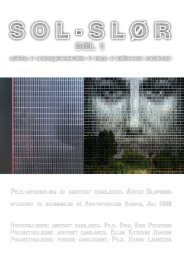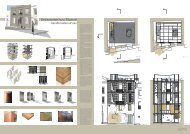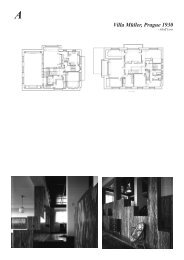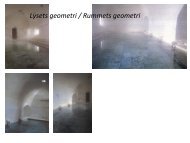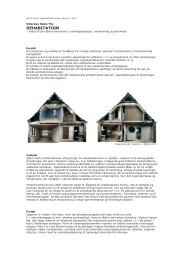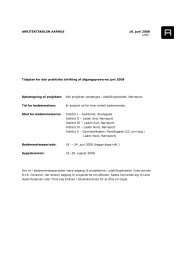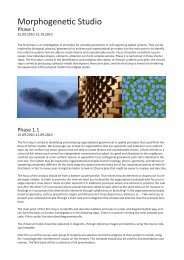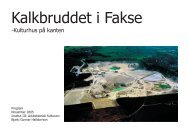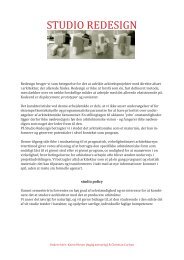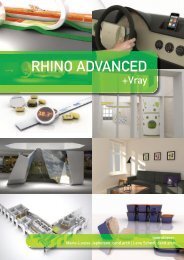Does Aarhus ring a bell?
Does Aarhus ring a bell?
Does Aarhus ring a bell?
You also want an ePaper? Increase the reach of your titles
YUMPU automatically turns print PDFs into web optimized ePapers that Google loves.
Special Advertising Supplement<br />
<strong>Does</strong><br />
<strong>Aarhus</strong><br />
<strong>ring</strong> a <strong>bell</strong>?<br />
It might be our world-class university. It might be our innovative solutions to<br />
global problems. It might be the architecture or the 150-metre-long rainbow<br />
on top of our museum. Who knows? No matter where you have heard about<br />
our city, <strong>Aarhus</strong> is making its mark on our planet as we speak.<br />
Learn how inside.<br />
03 Long live entrepreneurship<br />
Citywide collaboration is the real differentiator<br />
06 Capital of wind energi<br />
The world’s largest wind turbine manufacturer<br />
moves to <strong>Aarhus</strong><br />
11 Form and function at its finest<br />
<strong>Aarhus</strong> has the architectural foundation for growth<br />
14 From India to <strong>Aarhus</strong><br />
Building a life as expat in Denmark<br />
Photo: Ann Schyberg
Special Advertising Supplement<br />
<strong>Aarhus</strong>. Danish<br />
for Progress<br />
From the economy to the environment and<br />
the future of welfare; In <strong>Aarhus</strong>, people work<br />
together to find innovative solutions to the<br />
world’s problems.<br />
When the Japanese technology giant Panasonic was looking for<br />
the ideal place for its Robot Development Center to test welfaretechnology<br />
aimed at nursing homes and hospitals, Denmark was<br />
a first and natural place to look. With its historically strong focus<br />
on welfare, Denmark offered access to the most modern and extensive<br />
knowledge in welfare technology. As a result, Panasonic<br />
now develops welfare technologies, such as robotic beds, in the<br />
city of <strong>Aarhus</strong>.<br />
continues page 4 →<br />
Short facts about <strong>Aarhus</strong><br />
Second largest city in Denmark<br />
Population: 310.000<br />
Population within a 1-hour drive: 1.2 million<br />
Number of students: 40.000<br />
Number of international full-adegree students at<br />
<strong>Aarhus</strong> University: 2.917<br />
Number of degree programmes taught in English: 67<br />
Percentage of residents enrolled in a University<br />
programme: 13%<br />
Jacob Bundsgaard, Mayor of<br />
<strong>Aarhus</strong>, is spearheading an effort<br />
to create a new innovation fund<br />
supporting projects that will help<br />
solve the demographic challenges<br />
of the future.<br />
Photo: Jacob Lerche<br />
2
Special Advertisement Supplement<br />
Where<br />
food of<br />
the future<br />
is designed<br />
Agro Food Park in north <strong>Aarhus</strong> anticipates<br />
accommodating 3,000 science-based jobs<br />
in 10 years. The goal is to become a worldclass<br />
player in the food sector.<br />
The demands of food and agricultural<br />
production in the future are numerous. And<br />
there is plenty of money, competitiveness<br />
and potential for those with the right solution.<br />
Solutions for the food of the future are partly<br />
to be found in the knowledge and innovation<br />
park of Agro Food Park in Skejby in northern<br />
<strong>Aarhus</strong>.<br />
The goal is for the park to be one of the<br />
world’s five strongest competitive centres for<br />
innovation and knowledge within the agriculture<br />
and food sector by 2020, with a team of<br />
50 companies and 3,000 employees.<br />
Bjarne Langdahl Riis is the innovation<br />
manager for Agro Food Park. He is currently<br />
witness to the park’s rapid expansion and<br />
development.<br />
“We have a waiting list for new companies,<br />
so there is a lot of interest. On January 1st, we<br />
will be welcoming 16 new companies, taking<br />
the total number of employees to 800, which<br />
enables us to create both an international and<br />
national identity for agriculture and food.”<br />
UNIQUE CO-OPERATION<br />
The framework, concept and backing are in<br />
place, companies are streaming in, and the<br />
co-operation with <strong>Aarhus</strong> University and the<br />
agricultural community is simply unique.<br />
“We are creating the framework for innovation<br />
in the food industry, and knowledge is<br />
our product. Our strength lies in facilitating<br />
the entire chain, and this must hang together.<br />
Feed the world 2050 – this is our focus<br />
together with international researchers and<br />
companies. Knowledge is the future for Denmark,”<br />
believes Bjarne Langdahl Riis.<br />
Part of Agro Food Park’s focus is for the<br />
world to have sufficient and healthy food by<br />
2050.<br />
“There must be environmentally-friendly<br />
production methods, and if this is to be<br />
achieved, we must work together both nationally<br />
and internationally. <strong>Aarhus</strong> and East<br />
Jutland harbour plenty of opportunities with<br />
their high concentration of jobs and knowledge<br />
within the food, agriculture and energy<br />
sectors. 30.000 people with a long specialized<br />
education in science are gathered within<br />
one square kilometre, and the infrastructure<br />
is first class. So all the pre-requisites are in<br />
place here, including a university that wants<br />
to be involved,” says Bjarne Langdahl Riis.<br />
Agro Food Park also works on an international<br />
scale.<br />
The goal is to be a permanent player when<br />
the big food companies in the region work<br />
with innovative international activities.<br />
STACKS OF OPPORTUNITY<br />
Neighbours in Skejby include Vestas, NRGI,<br />
Rambøll, VIA and, last but not least, the<br />
New University Hospital, which with its ultra<br />
modern facilities and latest health education<br />
courses, is an obvious collaboration partner<br />
in many areas.<br />
“We are working with the docters at the<br />
hospital on what symptoms they see in their<br />
patients. Diabetes and obesity are public<br />
diseases, and today’s foods do not fill you<br />
up. When people have such a poor diet,<br />
we need everyone in the health service on<br />
board to develop the right food, and this is<br />
where we become a force to be reckoned<br />
with.”<br />
Agro Food Park is a knowledge park – a nerve centre for building of exchanging knowledge between universities, companies,<br />
organisations and municipalities that are active in the agriculture, energy and food sector. Agro Food Park’s goal is to be able<br />
to compete on both a national and international scale, providing optimum conditions for knowledge sha<strong>ring</strong> and innovation.<br />
The park will act as the leading sales pitch for Denmark as a European competitive centre for agriculture, energy and food<br />
innovation. The goal is for Agro Food Park to accommodate 3,000 science-based jobs by 2020. www.agrofoodpark.dk
Special Advertising Supplement<br />
<strong>Aarhus</strong> attracts international attention<br />
Panasonic is an example of how a Danish city, <strong>Aarhus</strong>, attracts<br />
attention from an international giant. The opposite, that a small<br />
local company develops a product that becomes a worldwide<br />
success, is the case of CLC Bio.<br />
The company was founded in 2005 by brothers Thomas and<br />
Bjarne Knudsen. Bjarne had finished a PhD in bioinformatics<br />
from the University of <strong>Aarhus</strong> and invented a piece of software<br />
that made it easier for biologists to analyze DNA. Thomas decided<br />
to help him find investors and build a company on the idea.<br />
“Today, researchers around the world use our software to research<br />
things such as genetic disorders and bio-fuels,” explains<br />
Lasse Görlitz, director of communications at CLC Bio.<br />
The company’s customers include MIT, Harvard University, and<br />
the world’s 10 largest medical companies. But CLC Bio enjoys<br />
<strong>Aarhus</strong>, just as investors and board members are predominantly<br />
from the city.<br />
“Graduates from <strong>Aarhus</strong> University are among the most<br />
attractive in the fields of bioinformatics and software<br />
enginee<strong>ring</strong>. In terms of attracting employees from abroad,<br />
the city is unique in terms of beautiful nature, coupled with<br />
its size and relaxed, youthful atmosphere,” Görlitz says.<br />
A city of entrepreneurs<br />
<strong>Aarhus</strong> University, which ranks 86th in the Academic Ranking<br />
of World Universities, is a major factor behind students’ and<br />
businesses’ interest in <strong>Aarhus</strong>. Recently, <strong>Aarhus</strong> University was<br />
named the leading entrepreneurial institution in Denmark by<br />
the Danish Enterprise and Construction Authority. The decision<br />
to award this distinction was partially based on the fact that all<br />
students receive some form of training in entrepreneurship, no<br />
matter what subject they study.<br />
“This is a tremendous strength for graduates, whether they decide<br />
to start their own business or pursue a career in an existing<br />
company. Having skills in entrepreneurship is always an asset<br />
in today’s global knowledge society,” says Pro-Rector Søren E.<br />
Frandsen.Being able to b<strong>ring</strong> together talented people across<br />
disciplines in physical space is another reason <strong>Aarhus</strong> attracts<br />
people and businesses. Combining knowledge with political vision<br />
and financial solutions is another.<br />
Last month, despite the economic downturn experience across<br />
the country and world, of the city government decided to set<br />
aside 40 million DKK a year from 2013 to create a development<br />
fund for innovation projects. Projects will focus on innovative<br />
ways to strengthen public service – in areas such as children,<br />
schools, rehabilitation and the elderly, without added costs.<br />
“We developed a new brand for the city called ‘<strong>Aarhus</strong> – Danish<br />
for Progress.’ What the brand says is that the city tries to offer<br />
the best possible framework for innovation, development and<br />
growth needed to meet the challenges of the future,” says Jacob<br />
Bundsgaard, Mayor of <strong>Aarhus</strong>.<br />
A growing city<br />
The hospital of the future<br />
<strong>Aarhus</strong> is growing. The city attracts an increasing number<br />
of residents, employees, businesses and students, and as a<br />
result, new development and construction is booming. In the<br />
next 10 years, a substantial part of the <strong>Aarhus</strong> Harbour will<br />
be turned into a new city neighbourhood with businesses,<br />
residential areas, research institutions – such as a new<br />
center for energy research called Navitas, a multimedia hub<br />
and a library – and a multimedia hub and library. The new<br />
harbour area will be home to 7.000 residents and 12.000<br />
employees.<br />
Photo: C.F. Møller<br />
Across the city, planned building projects amount to<br />
more than 45 billion DKK.<br />
www.businessaarhus.com<br />
Founded by Vikings – inhabited<br />
by students<br />
Founded by the Vikings around year 700, <strong>Aarhus</strong> is one<br />
of Denmark’s oldest cities. At the same time, its inhabitants<br />
are younger than average – more than one in ten is<br />
a student. With <strong>Aarhus</strong> University (AU) among the leading<br />
universities in the world, more than 40.000 students – from<br />
Denmark and abroad – study at AU or one of the city’s<br />
other 130 educational institutions.<br />
<strong>Aarhus</strong> and the Region of Central Denmark is building<br />
Northern Europe’s largest university hospital. When ready in<br />
2019, the hospital will take up 344.000 m2, receive 900.000<br />
in- and outpatients a year.<br />
The hospital is designed as a small city with neighbourhoods,<br />
streets, and squares creating a dynamic and green city.<br />
Light, fresh air and single occupancy rooms are important<br />
ingredients to faster healing, according to the <strong>Aarhus</strong>based<br />
architects C. F. Møller, who have taken an innovative<br />
approach to design called “healing architecture”.<br />
From the get-go, the hospital was designed to meet future<br />
demands for technology, therapies and ways of working –<br />
much of which is unknown today.<br />
4
Special Advertisement Supplement<br />
Visualise<strong>ring</strong>: C. F. Møller Landskab<br />
Keeping traffic<br />
By Gunnar Lomborg<br />
moving in <strong>Aarhus</strong><br />
Atkins, Europe’s largest consultancy firm, is working to make <strong>Aarhus</strong> easier to navigate.<br />
Atkins are experts in infrastructure. While the<br />
consultancy firm’s strengths lie in railways,<br />
it also has experts in roads and air transport<br />
who can help the state and municipalities find<br />
the best possible solutions in these areas.<br />
Atkins has already worked, and continues to<br />
work, on a number of projects in <strong>Aarhus</strong>, as<br />
the city undergoes rapid development.<br />
“We are working on a number of projects in<br />
and around <strong>Aarhus</strong>, such as strategic analyses<br />
to ease traffic congestion. We have also consulted<br />
on the future light rail project in <strong>Aarhus</strong>,<br />
a project closely connected to the Grenaa<br />
and Odderbane link, which is going to enable<br />
easier and faster access to and from the city,”<br />
explains Head of Department for Planning &<br />
Analysis, Anders H. Kaas.<br />
END TO TERMINUS STATION<br />
Atkins was involved in the development of<br />
the station area in <strong>Aarhus</strong>, which led to the<br />
creation of Bruuns Gallery and the harbour rail<br />
track, the latter enabling freight traffic to and<br />
from the harbour. The long-term aim could<br />
be to “open up” <strong>Aarhus</strong> railway station, so the<br />
north-south railway traffic can pass through it.<br />
<strong>Aarhus</strong> is currently similar to what you might<br />
call a terminus station, where the trains have<br />
to turn round and leave the same way they<br />
came in, which slows down rail traffic.<br />
“In addition to railway projects, we have also<br />
taken part in studies about the position of a<br />
city airport – a project greatly demanded for<br />
the business community. We have investigated<br />
whether there is a need and willingness<br />
to invest, and whether it would be profitable,<br />
especially in the light of a possible new and<br />
permanent link to Kattegat. We are also working<br />
on studies of how to ease cycle traffic, and<br />
how to get all traffic types working together<br />
so that we can help <strong>Aarhus</strong> limit congestion<br />
problems by increasing the use of bikes,”<br />
underlines Anders H. Kaas.<br />
BILLION KRONER PROJECTS<br />
Atkins Denmark has head office in Copenhagen<br />
and local offices in <strong>Aarhus</strong>, Horsens<br />
and Esbjerg. However, the company works<br />
all over Denmark, especially on the large<br />
railway projects, which must ensure the public<br />
transport can handle congestion in the<br />
future. Atkins has been selected as the consultancy<br />
firm for projects such as The Metro<br />
Circleline “City<strong>ring</strong>en”, the construction of<br />
a railway line between Copenhagen and<br />
Ringsted, and the 6th main track in Copenhagen’s<br />
Central Station, as well as two new<br />
main tracks between Copenhagen’s central<br />
station and Ny Ellebjerg. Atkins is even<br />
involved in Europe’s largest re-signalling<br />
scheme; the upgrading of the entire Danish<br />
railway signalling infrastructure, a project<br />
worth billions of kroner.<br />
”Our strength lies in working with projects<br />
like these in many countries on a large scale.<br />
The experience we have achieved enables us<br />
to see the overall perspective in local projects,<br />
and get them to work with the rest of their<br />
surroundings. It all has to connect together,<br />
and we are experts in getting it to do that”,<br />
highlights Anders H. Kaas.<br />
Photo Ole Johnny Sørensen<br />
Atkins has head offices in the UK, and employs 17,500 people worldwide. In Scandinavia Atkins is represented<br />
in Denmark, Norway and Sweden with a total of 550 employees, of which 400 are in Denmark.<br />
Atkins’ areas of specialisation are: Transport planning and analyses, railways, light rail and metros, bridges<br />
and constructions, GIS (geographical information systems), energy, environment and architecture.
Special Advertising Supplement<br />
<strong>Aarhus</strong> –<br />
Capital of<br />
Wind Energy<br />
This month, the world’s largest wind turbine manufacturer, Vestas, moves its<br />
headquarters to <strong>Aarhus</strong>. In September, Chinese officials visited the city to get<br />
ideas on how to solve the country’s looming energy crisis. It took an innovative<br />
public and private effort for <strong>Aarhus</strong> to get this far.<br />
When Harvard Business Review in September named Vestas<br />
Wind Systems the 11th most innovative company in the world<br />
(Salesforce.com being number 1 and Apple number 5), it was the<br />
result of years of pursuing an aggressive innovation strategy by<br />
the Danish wind energy giant.<br />
Last year, Vestas spent 2,8 billion DKK on R&D. In five years,<br />
the number of employees in R&D has quadrupled to 2.277, the<br />
largest such research department in the world. Founded in 1898<br />
by a 22-year-old Danish blacksmith named Hansen, Vestas<br />
Wind Systems today is a global market leader in developing and<br />
producing windmills. The company, with 20.000 employees and<br />
a global market share of 12,5 %, this month moves its headquarters<br />
to <strong>Aarhus</strong>.<br />
As capital of wind energy, the <strong>Aarhus</strong> area today generates 87 %<br />
of Denmark’s combined turnover from wind energy. Last month,<br />
the Finnish wind turbine manufacturer Winwind announced that<br />
they are opening a branch in the city, and days later, a Chinese<br />
delegation of energy officials visited <strong>Aarhus</strong> to find inspiration for<br />
how the giant country can solve its energy challenge.<br />
A historically strong focus on wind<br />
The ability to attract the wind energy leaders to <strong>Aarhus</strong> is a consequence<br />
of the historically strong political, technological and industrial<br />
focus on renewable energy. Denmark was the first country<br />
to implement wind power in energy production, building on a<br />
vision of becoming less reliant on fossil fuels. In addition, <strong>Aarhus</strong><br />
was among the first cities in Denmark to map its CO2-emissions,<br />
and today has set an ambitious goal of becoming CO2-neutral<br />
by 2030. Political initiatives such as these have paved the way<br />
for the close cooperation between public authorities, research<br />
institutions, businesses, NGOs and citizens necessary to develop<br />
a successful industry. As a consequence, <strong>Aarhus</strong> has become a<br />
global market-leader in wind energy.<br />
“Not only are some of the world’s largest<br />
wind energy producers located in or<br />
around <strong>Aarhus</strong>. The region is also home to<br />
the largest cluster of suppliers, including<br />
a strong research community, as well as a<br />
growing cluster of clean-tech companies,”<br />
says Laura Hay, Alderman at the City of<br />
<strong>Aarhus</strong>, Department of Technical Sevices<br />
and Environment.<br />
Strong focus on R&D<br />
The strong network of suppliers to the wind energy and cleantech<br />
industries in <strong>Aarhus</strong> generate increased investments in R&D.<br />
6
Special Advertising Supplement<br />
Navitas Park – Discove<strong>ring</strong> the<br />
future of energy<br />
Central Denmark and <strong>Aarhus</strong> play<br />
an important role for Vestas. There<br />
is a special know-how, knowledge<br />
and understanding of our products<br />
and the wind industri in general<br />
among employees, local residents,<br />
politicians and educational<br />
institutions.<br />
(Ditlev Engel, Vestas)<br />
<strong>Aarhus</strong> is already the Capital of Wind Energy. Now, the<br />
City is developing a new flagship centre for green energy,<br />
called Navitas. In 2014, the 37,000 square metre building<br />
on <strong>Aarhus</strong> Harbour will house 2,000 students and more<br />
than 300 researchers and entrepreneurs in the field of<br />
green energy research.<br />
Photo: Rasmus Baaner<br />
Ditlev Engel,<br />
President and CEO, Vestas<br />
<strong>Aarhus</strong> is home to a strong research focus on offshore wind<br />
energy production, among other things.<br />
According to Deloitte Consulting, 63 % of suppliers to the wind<br />
energy industry increased their R&D activities in the past year. On<br />
average, only 38 % of businesses did the same.<br />
Two examples of suppliers, Schaeffler Group and ECM Industries,<br />
both with offices in the <strong>Aarhus</strong> area, last month announced that<br />
they are increasing investments in research and development.<br />
14.000 employees, or 53 % of everyone working in the wind<br />
energy industry, work in or around <strong>Aarhus</strong>.<br />
(Monday Morning consulting, 2010)<br />
”We expect increasing R&D activities in the following years. More<br />
international companies set up R&D departments in Denmark,<br />
and we need to create an innovation-driven business if we are<br />
to meet global competition,” says Esben Jaedicke Christiansen,<br />
director of sales at ECM Industries.<br />
<strong>Aarhus</strong> as a first mover<br />
Vestas CEO Ditlev Engel points out that <strong>Aarhus</strong> has become<br />
a strong knowledge cluster on wind energy. “Central Denmark<br />
and <strong>Aarhus</strong> play an important role for Vestas. There is a special<br />
know-how, knowledge and understanding of our products and<br />
87 % of the combined turnover from wind energy in Denmark<br />
is generated by businesses based in or around <strong>Aarhus</strong>.<br />
(Monday Morning consulting, 2010)<br />
the wind industry in general among employees, local residents,<br />
politicians and educational institutions,” says Ditlev Engel.<br />
Attracting international employees<br />
The increasing internationalization of the city is also important for<br />
Vestas.<br />
“<strong>Aarhus</strong> is the most international city in the region. In order to<br />
attract and keep the workforce we need, both domestic and<br />
international, we have chosen to locate our new base in <strong>Aarhus</strong>.<br />
We think it has the right facilities – also outside of office hours. At<br />
Vestas, we have 19 different nationalities working in the <strong>Aarhus</strong><br />
area at our different locations, so we have to be able to offer<br />
them something. <strong>Aarhus</strong> has the size for critical mass to shape a<br />
wind energy cluster” Engel says.<br />
The Vestas CEO is especially happy that <strong>Aarhus</strong> has strengthened<br />
its international focus by establishing “International Community”,<br />
a one-stop-shop to help international workers and their<br />
spouses with the transition and stay in <strong>Aarhus</strong>. He also is thrilled<br />
that the City now offers international education, from kindergarten<br />
to elementary schools, an international high school and<br />
university.<br />
7
Special Advertisement Supplement<br />
Hospital<br />
Medical<br />
Director<br />
develops<br />
interest<br />
in concrete<br />
Hospital Medical Director Claus Thomsen and<br />
Architect Lars Juel Thiis in the project department<br />
of the New University Hospital.<br />
They have developed a common language and<br />
common reference parameters in order to create<br />
a hospital where the physical setting plays an<br />
active role in healing the patient.<br />
The Healthcare Staff<br />
are talking the same<br />
language as the<br />
Architects, and the<br />
architects the same<br />
language as the<br />
Hospital Staff. The<br />
result is a healing<br />
hospital, where the<br />
building itself makes<br />
the patient feel<br />
better and leads<br />
to faster discharge.<br />
By Søren Bloch<br />
Hospital Medical Director Claus Thomsen<br />
has learned to speak a new language. He can<br />
now talk about space, acoustics and building<br />
terms – and the beauty of concrete. Terms that<br />
normally belong to the world of Lars Juel Thiis.<br />
He is an Architect, and he has also learned a<br />
new language. Now he knows how to talk about<br />
patients’ needs and recovery.<br />
The pair of them, the Medical Director and the<br />
Architect, are just some of the key people in the<br />
large organisation behind one of Denmark’s most<br />
exciting construction projects: DNU – or ‘Det<br />
Nye Universitetshospital’ (New University Hospital)<br />
in <strong>Aarhus</strong>, of which the Central Denmark<br />
Region is the developer of. The construction<br />
will gather hospital buildings from four different<br />
addresses in <strong>Aarhus</strong> into a new hospital town<br />
based in Skejby.<br />
A HEALING HOUSE<br />
Claus Thomsen notes the Architect’s reference<br />
to a ‘healing house’.<br />
”The physical construction of the house affects<br />
those that enter it. Hospitals can often be very<br />
sobe<strong>ring</strong>, and rarely make you feel at home.<br />
This is a barrier we want to break down by using<br />
more sensuous elements such as art, design<br />
and indoor climate,” explains Lars Juel Thiis.<br />
That is why all the hospital wards have been designed<br />
with private wards. And views are either<br />
of the surrounding nature or areas of life outside.<br />
“It is particularly important for elderly patients<br />
to be able to follow what is going on outside,”<br />
adds the Medical Director.<br />
However, this is not the only reason for<br />
designing welcoming private wards.<br />
”This has been done from a rational perspective.<br />
On a private ward the majority of treatment<br />
can take place on the ward itself, there is<br />
reduced risk of cross-infection, and the patients<br />
can make themselves more at home,” explains<br />
Claus Thomsen.<br />
”I am certain that it is worth the money as it will<br />
lead to shorter spells of hospitalisation,” he adds.<br />
IF IT ISN’T FACT…<br />
As a doctor, he needs certainty. He is used<br />
to working with tangible and scientific results.<br />
Something that can be proven.<br />
For the Architect, however, evidence is often<br />
sufficient. Evidence builds on the best available<br />
information from research and evaluation.
Special Advertisement Supplement<br />
A united University Hospital<br />
Why spend 6.4 billion kroner on a new<br />
University Hospital in <strong>Aarhus</strong>? We asked<br />
Chairman of the Council of the Central<br />
Denmark Region, Bent Hansen:<br />
“We need a completely new hospital in<br />
<strong>Aarhus</strong> because the current hospital buildings,<br />
and especially <strong>Aarhus</strong> Hospital, are<br />
worn down, outdated and have limited<br />
expansion possibilities. The old Municipal<br />
Hospital buildings are up to 125 years old,<br />
and there are currently 25,000 transportations<br />
of patients, healthcare staff and<br />
doctors a year between the four hospital<br />
campuses in <strong>Aarhus</strong>. We avoid all this<br />
with the New University Hospital, where<br />
all specialities, including psychiatry, for the<br />
first time will be gathered in one place.<br />
Read more about the construction on:<br />
www.dnu.rm.dk<br />
Research close to patients<br />
Photo: Hartmann Schmidt<br />
Even health research will benefit from<br />
new surroundings in the New University<br />
Hospital. These will be located in a<br />
so-called Core centre, where research<br />
will be conducted close to the patients.<br />
The Core centre is expected to create an<br />
international environment that will attract<br />
foreign researchers.<br />
And there is plenty of evidence to show that<br />
surroundings play an important role in patient<br />
recovery. And on staff welfare.<br />
“Doctors are often sceptical about scientific results<br />
if something cannot be proven,” says Lars Juel<br />
Thiis. To him, the soft values are just as important.<br />
Even if, according to the Medical Director,<br />
the Architect speaks ‘the language of art’, he<br />
respects that there are clear studies behind his<br />
theories. These indicate that you feel better in<br />
buildings that have a positive effect on you.<br />
A FRUITFUL MEETING OF CULTURES<br />
More formally one could describe the meeting<br />
between the Medical Director and the Architect<br />
as a meeting of cultures. We will suffice to call it<br />
a good and fruitful collaboration between several<br />
different trade groups.<br />
The common language has played a crucial role,<br />
and each party has had their eyes opened to the<br />
other’s needs from the building.<br />
“With my new nomenclature – doctor’s speak<br />
for vocabulary – I have learned some trade terms<br />
that I can use to express myself differently,” says<br />
Claus Thomsen.<br />
He explains that clinicians and healthcare staff<br />
often stick to what is known, while the Architect<br />
thinks about the future of buildings.<br />
AH, THAT’S HOW YOU DO IT<br />
It has led him to have quite a few ‘ah’ moments.<br />
Like when a solution was needed for the hospital’s<br />
emergency ward.<br />
In a doctor’s world, the emergency ward is where<br />
all functions are on the same level to make<br />
things as easy as possible. But at the New<br />
University Hospital, the proportions were too<br />
large for this to be feasible.<br />
The Architect’s solution was a staircase and a<br />
glass opening, so that there is no barrier between<br />
the floors. The staff can run about freely and also<br />
shout to the floor above and below them.<br />
”You are able to follow what others are doing.<br />
The transparency creates better conditions for<br />
everyone,” says the Medical Director, who even<br />
in his private life has begun to look at buildings<br />
differently.<br />
“I have even become interested in whether a<br />
specific type of concrete in a building is good<br />
or bad,” says Claus Thomsen with a smile.<br />
Luxury with a point<br />
At first glance it appears like obscene<br />
luxury for all patients in the New University<br />
Hospital to have their own private ward.<br />
But there are several good reasons for this.<br />
<br />
<br />
<br />
<br />
<br />
<br />
conversations<br />
All factors that result in faster recovery<br />
and discharge of the patient.
Special Advertisement Supplement<br />
It’s a passion<br />
- It’s a way of life<br />
The <strong>Aarhus</strong> School of Architecture has the entire world as its business partner. “This is<br />
crucial for ongoing development and regeneration,” says principal Torben Nielsen. And<br />
it provides plenty of inspiration and committed students with vision, ideas and a desire to<br />
think out of the box in a constantly changing world.<br />
The world is increasingly coming to the<br />
<strong>Aarhus</strong> School of Architecture, which benefits<br />
from firm partnerships with other architecture<br />
schools in places such as Sydney and<br />
Beijing. And more locations are to come. The<br />
school’s students also get out into the world<br />
via study or work placements.<br />
It is the result of a conscious effort on an<br />
international focus. The <strong>Aarhus</strong> School of<br />
Architecture currently provides a range of<br />
courses for Masters students, whereby all<br />
teaching is conducted in English. Students<br />
from all over the world attend a two year<br />
course that ensures that foreign students<br />
become socially integrated in the school<br />
and city, while also strengthening the Danish<br />
students’ international skills. Students who<br />
complete the course gain an “International<br />
Master of Architecture”.<br />
For principal Torben Nielsen, this is a natural<br />
development.<br />
“International co-operation is crucial for ongoing<br />
development and regeneration. As an<br />
educational and research institution in a minor<br />
city in a small country, we place great importance<br />
on international exchange. We send<br />
researchers, teachers and students out into<br />
the world to other architecture schools, and<br />
we also attract foreign lecturers, researchers,<br />
teachers and students to our school.”<br />
NEW TECHNOLOGY AND CORE SKILLS<br />
Du<strong>ring</strong> September the school held a major<br />
international workshop entitled ”Digital<br />
Physical”. The workshop focussed on the<br />
relationship between experimental digital<br />
tools and computer-aided fabrication; the<br />
students’ projects were taken from the PC<br />
and turned into actual physical models.<br />
“We generally expect students to have the<br />
chance of turning their projects and ideas<br />
into models, and preferably on a 1:1 scale,”<br />
says Torben Nielsen and explains that “it<br />
gives the students a true feel of what they are<br />
working with.”<br />
The <strong>Aarhus</strong> School of Architecture teaches<br />
all subjects areas, from building design to<br />
physical planning. Regardless of the subjects<br />
you choose, focus remains on the core skills:<br />
the artistic approach to the task and the ability<br />
to work spatially and visually.<br />
ENGAGING THROUGH ARCHITECTURE<br />
The school is based in the city centre and<br />
works closely with the city’s numerous<br />
architecture firms. Thanks to the School<br />
of Architecture, <strong>Aarhus</strong> currently has the<br />
densest concentration of architects in the<br />
whole world. The interaction that exists<br />
between the school and the real profession<br />
has been highlighted as a role model by<br />
the Danish Ministry of Trade and Industry.<br />
“We engage with the world around us, including<br />
the city we are a part of. Throughout<br />
the autumn, all of the school’s 800 architecture<br />
students will be working on <strong>Aarhus</strong>,<br />
under a project entitled “<strong>Aarhus</strong> Urban Lab”.<br />
They will capture the city and create projects<br />
based on the city’s squares, marketplaces<br />
and spaces. The project will be achieved together<br />
with architecture firms, municipalities,<br />
cultural institutions etc. And in close dialogue<br />
with the city’s citizens. The project is to be<br />
included in the <strong>Aarhus</strong> Festival 2012 and in<br />
<strong>Aarhus</strong>’s bid to become the European Capital<br />
of Culture in 2017,” explains Torben Nielsen.<br />
The school has also been invited to take part<br />
in the international architecture biennial in<br />
Venice in 2012, together with a number of<br />
Danish and Greenlandic architect firms, the<br />
theme being Future Greenland. 30 Masters<br />
students will work on the project<br />
in the coming year, in close collaboration<br />
with <strong>Aarhus</strong>-based architecture firms CEBRA<br />
and Transform.<br />
“Engaging through architecture’ is our<br />
vision,” concludes head Torben Nielsen.<br />
Or as one student replied when asked to<br />
describe his studies at the <strong>Aarhus</strong> School<br />
of Architecture, “It’s a passion – It’s a way<br />
of life”.<br />
The <strong>Aarhus</strong> School of Architecture is a further educational establishment under the Danish Ministry of Research, Innovation and Further<br />
Education. The school provides graduate courses, a two year Masters, and a PhD, and has approx. 800 registered students and approx.<br />
100 full-time teachers and researchers. Around 20 pct. of the school’s students come from abroad. Read more about the <strong>Aarhus</strong> School of<br />
Architecture on http://en.aarch.dk
Special Advertising Supplement<br />
A<br />
dynamic<br />
beauty<br />
<strong>Aarhus</strong> wins praise from a prize-winning architect who<br />
enjoys the view and energy of the city.<br />
As one of Denmarks leading architects, Mads Møller (70), partner<br />
in the prize-winning <strong>Aarhus</strong>-based firm C.F. Møller Architects, has<br />
a keen understanding of what makes a city great.<br />
<strong>Aarhus</strong>, the city to where his father C.F. Møller started the company<br />
in 1931 with the design of the University of <strong>Aarhus</strong> and the<br />
hospital of <strong>Aarhus</strong>, is dear to him.<br />
As he sits on the top floor of the 13-story tall office building<br />
“Europa-house” near the harbour with a 360-degree view of the<br />
city, Mads Møller does not hesitate to call <strong>Aarhus</strong> beautiful.<br />
“The geometry of the city is perfectly balanced. Nestled by the<br />
sea, with green woods on either side of the harbour, the city has<br />
a bowl-like shape. Whether you drive in from the North, West,<br />
or South, you get a magnificent view over the city,” Mads Møller<br />
says.<br />
Since he became a partner in the company 45 years ago, Mr.<br />
Mads Møller has been greatly involved in shaping <strong>Aarhus</strong> as a<br />
modern metropolis. “What makes <strong>Aarhus</strong> stand out from other<br />
cities is the success with which the city has been able to combine<br />
residential areas, office buildings and a working harbour. The<br />
fact that people can live and work right next to a modern, working<br />
harbour – one of Europe’s largest container harbours – gives<br />
<strong>Aarhus</strong> a dynamic energy that is probably part of the reason, the<br />
city continues to grow,” explains Møller.<br />
characterized by quality in materials and sustainability, as well as<br />
simplicity in planning, economy and design,” he says.<br />
The company’s success also has a great deal to do with being<br />
able to find great talent in the city – with the School of Architecture<br />
located here and a bustling and young design and architectural<br />
community in the city.<br />
“<strong>Aarhus</strong> is big enough to attract great talent, and big enough<br />
to surprise you. But it doesn’t overwhelm you. And if you have<br />
a good idea, as architects often do, the city is small enough to<br />
make things happen. That’s quite exciting,” Mads Møller says<br />
and looks out.<br />
The fog and rainy clouds clog his view today. But construction<br />
across the city carries on. And he follows it all from the 13th floor.<br />
Mads Møller,<br />
Partner, Arkitekt MAA<br />
Photo: Jacob Lerche<br />
Architects of the world – Danish style<br />
With 320 employees, 9 partners and an associate partner, C.F.<br />
Møller today in an international firm with offices and design projects<br />
all over the world. Among them the National Diabetes Center<br />
in Riyadh, Saudi Arabia, a Gastronomic Academy at the San Martino<br />
museum in Naples, Italy, and the Stockholm Globe Arena.<br />
But <strong>Aarhus</strong> is still the company’s headquarters. As such, the<br />
city offers a great deal of quality and inspiration, according to<br />
Mads Møller. “Our architecture is Danish, or Nordic, in style. It is<br />
A hub for architecture and design<br />
With 330 registered architecture firms and 492 design<br />
companies (such as graphic -, industrial -, product and<br />
communications design) <strong>Aarhus</strong> has the largest concentration<br />
of architects and designers in the country. Two of Europe’s<br />
largest architectural firms, C. F. Møller and Schmidt Hammer<br />
Lassen, are based in the city, as well as the School of<br />
Architecture and a list of other design studies in and close to<br />
<strong>Aarhus</strong>.<br />
11
Special Advertising Supplement<br />
Photo: Morten Jac<br />
<strong>Aarhus</strong> cycles the Earth<br />
21 times a day<br />
3,2 kilometres a day: Every resident<br />
between the age of 10 and 84 bikes<br />
an average of 3,2 kilometres a day, 21<br />
times around the world.<br />
450,021 metres: the length of the total<br />
public cycle lanes in <strong>Aarhus</strong><br />
1,512 metres: the length of an average<br />
bike ride in <strong>Aarhus</strong><br />
57: the number of city bike parking areas<br />
in <strong>Aarhus</strong>.<br />
A liveable city<br />
In recent years, the city of <strong>Aarhus</strong> has carried out an extensive excavation of<br />
the stream running through the city center. The result is an increased ambiance<br />
and activities along the water, where cafées, restaurants and small shops are<br />
attracting locals and visitors alike.<br />
Photo: Ole Hein Pedersen<br />
European Capital of Culture in<br />
2017?<br />
The City of <strong>Aarhus</strong> is aiming at becoming<br />
European Capital of Culture in 2017.<br />
The campaign to win the nomination<br />
is called “Rethink” – the idea of which<br />
is to rethink the way in which culture,<br />
business and government could work<br />
together to create the attractive city of<br />
the future.<br />
Photo: Malling and Schmidt<br />
Olafur Eliasson’s Your Rainbow Panorama<br />
He has created waterfalls under the Brooklyn Bridge in New York, exhibited at<br />
the Tate Modern and around the world. This year, the Danish-Icelandic artist<br />
Olafur Eliasson’s largest project to date, Your Rainbow Panorama opened atop<br />
ARos <strong>Aarhus</strong> Museum of Art.<br />
The rainbow panorama is a permanent creation and a new landmark for <strong>Aarhus</strong>,<br />
consisting of a circle-shaped 150 metre long hallway made of rainbow-colored<br />
class. Resting on top of the museum, visitors can walk through the entire rainbow<br />
and get a coloured view of the city.<br />
“I created a space that removes the lines between inside and outside, you are<br />
unsure of whether you entered a piece of art or a part of the museum. This duality<br />
is important to me, because it encourages people to think and sense their surroundings,<br />
the city, in ways that are unfamiliar to them,” says Olafur Eliasson of<br />
his work.<br />
Your Rainbow Panorama is Eliasson’s most extensive work to date and has<br />
attracted national and international audiences to the museum and the city.<br />
We all scream for ice cream ...<br />
with oak?<br />
The most cutting-edge developments in<br />
ice cream, according to the Wall Street<br />
Journal, comes from Scandinavia. One<br />
<strong>Aarhus</strong>-based chef, Thorsten Schmidt,<br />
has made a creamy oak ice cream,<br />
made with shavings of the tree, which<br />
he serves at his restaurant Malling and<br />
Schmidt in <strong>Aarhus</strong>.<br />
Schmidt has won national and<br />
international fame as part of the New<br />
Nordic Food Manifesto – basing his<br />
cooking on ingredients and produce that<br />
thrive in the Nordic climate and using<br />
these products in new ways.<br />
12
AU<br />
AARHUS UNIVERSITY<br />
<strong>Aarhus</strong> – Special Advertising Supplement<br />
Special Advertising Supplement<br />
in<br />
n0<br />
AARHUS UNIVERSITY<br />
DANISH FOR INNOVATION<br />
The Centre for Entrepreneurship and Innovation at <strong>Aarhus</strong> University provides large<br />
and medium-sized businesses with one simple point of access to knowledge-based<br />
partnerships with leading researchers and specialized research centres.<br />
Want to fast forward your business on the runway to new products, services and<br />
global markets? Contact us today.<br />
www.cei.au.dk/innovation<br />
Danish for progress
Special Advertising Supplement<br />
From India<br />
to <strong>Aarhus</strong><br />
Photo: Jacob Lerche<br />
family adjusts to<br />
new ways of life<br />
Moving to <strong>Aarhus</strong> from Bangalore has been<br />
easy, says Venkat and Bhanu. Danes are a little<br />
reserved, but warm up when served Indian food.<br />
“Daddy, I want to watch Mickey Mouse?”<br />
says 5-year-old Jayanth Chalapati as his<br />
father Venkat tries to woo him away from<br />
the computer to get a family photo taken.<br />
“He is tired today, because he was in<br />
school until 2 PM,” says Jayanth’s mother<br />
Bhanu, who picked him up at the International<br />
School where he started in August.<br />
The family, from Bangalore India, moved to<br />
Denmark a few years ago when Venkat received<br />
a job offer as an enterprise architect,<br />
first with KMD and since October 2010 with<br />
Vestas Wind Systems.<br />
“Moving to Denmark has been a good<br />
experience for us. In India, we worked<br />
long hours, spent many hours a day on<br />
transportation to and from work, and didn’t<br />
get to spend time with Jayanth. The worklife<br />
balance is definitely better here,” says<br />
Bhanu, who worked as an IT specialist in<br />
India and hopes to find work in Denmark.<br />
In Bangalore, the family was able to afford<br />
a driver and a cook. In <strong>Aarhus</strong>, they use<br />
public transportation and Bhanu cooks.<br />
“She makes me Indian lunch to b<strong>ring</strong> to<br />
work every day. Danes love Indian food, so<br />
we often invite our close Danish friends for<br />
dinner at our home,” says Venkat Chalapati<br />
(38), who enjoys his work and says he has<br />
found several good friends among Danish<br />
colleagues.<br />
“We try to develop good relationships. It<br />
takes a little time with Danes, but we have<br />
several warm friendships already,” says Venkat,<br />
adding that he also likes Danish food.<br />
The family spends their time off travelling<br />
the country. They enjoy Denmark and<br />
believe they found a good place to live in<br />
<strong>Aarhus</strong>.<br />
“<strong>Aarhus</strong> is very green and also has enough<br />
opportunities, such as the international<br />
school and International Community. Raising<br />
our kid in an international setting is very<br />
important to us,” says Venkat.<br />
His wife smiles and says that she is thankful<br />
for the newsletters and events offered by<br />
International Community. “I read their newsletter<br />
every week, because they tell me in<br />
English what is going on in the city. They<br />
are very helpful,” Bhanu (37) says.<br />
In addition, she is developing a network<br />
among the parents of children at the International<br />
School, which is right across the<br />
street from the family’s apartment.<br />
“The mothers drop by, we drink Indian chai<br />
tea, and chat. It’s a good life,” she says,<br />
adding that she is applying for jobs. In<br />
Bangalore, she worked for companies such<br />
as Microsoft and Accenture.<br />
Asked to name the worst thing about Denmark,<br />
they laugh and say: “taxes”.<br />
<strong>Aarhus</strong> is an<br />
international city<br />
<strong>Aarhus</strong> offer international<br />
schools, day care, and<br />
networking for international<br />
employees and spouses<br />
<strong>Aarhus</strong> offers international day care and<br />
schooling for children from the age of<br />
3 through 18. The city has an elementary<br />
school, the International School of<br />
<strong>Aarhus</strong>, and next year, an IB-certified<br />
elementary school opens. Also, <strong>Aarhus</strong><br />
offers an international IB secondary<br />
school programme, as well as a long list<br />
of degrees and programmes at the University<br />
and other institutions of higher<br />
education.<br />
Networking for international<br />
employees and their families<br />
International Community (IC) offers<br />
access to a social and professional<br />
network for international employees<br />
and their families in <strong>Aarhus</strong>. IC helps<br />
expats find their way in terms of housing,<br />
schools, jobs for spouses and more.<br />
The center also has an online networking<br />
community, InterCom, a platform for<br />
connecting with other expats and finding<br />
information about life in <strong>Aarhus</strong>.<br />
www.isaa.dk<br />
www.internationalcommunity.dk<br />
Colophon<br />
Special advertising supplement from Municipality of <strong>Aarhus</strong>.<br />
www.aarhus.dk<br />
Lisbeth Katborg Bjerre, Head of Communication, Mayor’s Department,<br />
City of <strong>Aarhus</strong>, +45 23 32 83 62, lkb@aarhus.dk<br />
Produced by: C media Denmark A/S<br />
Project Manager: Peter Lundegaard, C media Denmark A/S,<br />
+ 45 48 44 49 29, peter@cmedia.as, www.cmedia.as<br />
Editor: Camilla Marcinkowski, Periskop<br />
Design: Hatch & Bloom A/S<br />
12
Special Advertising Supplement<br />
Get help for takeoff<br />
Did you know …<br />
that entrepreneurs and companies<br />
can get a subsidy to realise their<br />
growth ambitions?!<br />
Learn more about your options on www.imidt.dk<br />
Contact the Central Denmark Region’s business service<br />
on phone (+45) 70 15 16 18<br />
Shaping the future<br />
Ramboll is committed to help shaping the future of <strong>Aarhus</strong>. A goal the knowledge company is<br />
achieving through sizeable projects that build on citizen involvement, structured, innovative<br />
project management and world-class professional competence.<br />
In 2010 Ramboll initiated the cycling team<br />
‘Connecting <strong>Aarhus</strong>’, an active business<br />
network across the city.<br />
SIGNIFICANT AARHUS<br />
PROJECTS<br />
The New University Hospital and the sheer<br />
size of the project will impact the hospital’s<br />
users and the entire community.<br />
Navitas will become <strong>Aarhus</strong>’ new centre for<br />
energy, innovation and training at the local<br />
harbour areas in <strong>Aarhus</strong>.<br />
Urban Mediaspace <strong>Aarhus</strong> is an open and<br />
accessible learning environment that promotes<br />
democracy and community spirit.<br />
The strategy for growth is clear at Ramboll in<br />
<strong>Aarhus</strong>. Recent years have seen the company<br />
rebuilt, expanded and merged to become<br />
13,000 square metres of innovative environment,<br />
where many of the international projects<br />
in Ramboll’s global organisation are managed.<br />
“We really believe in the Greater <strong>Aarhus</strong> model<br />
as a parallel to the Copenhagen region. Through<br />
a ‘one company’ strategy we advantage from<br />
cross-dimensional knowledge sha<strong>ring</strong>. In<br />
<strong>Aarhus</strong> we have Ramboll Denmark and Ramboll<br />
Management with Attractor under the same roof<br />
which opens for many innovative ideas, says<br />
Ole Bech Jensen, Director and Area Manager for<br />
Ramboll in <strong>Aarhus</strong>.<br />
SOCIETY’S TEAMMATE<br />
Ramboll is deeply committed to developing<br />
<strong>Aarhus</strong> in close collaboration with the region’s<br />
key players. As a community consultant Ramboll<br />
develops together with the entire region.<br />
“Our role is to be a community consultant<br />
whereby we contribute to work and dialogues<br />
across <strong>Aarhus</strong>. We are involved in the large<br />
Eastern Jutlandic projects together with other<br />
key players,” adds Ole Bech Jensen.<br />
Ramboll highlights opportunities and provides<br />
forward-looking ideas.<br />
“The future requires new ways of working together,<br />
and we would like to be an active player<br />
and take a shared responsibility for the future<br />
of <strong>Aarhus</strong>, with knowledge, people and ideas<br />
that contribute to innovative solutions that get<br />
<strong>Aarhus</strong> moving.”<br />
Ramboll Danmark is a leading enginee<strong>ring</strong>,<br />
design and consultancy company and part<br />
of the Ramboll Group, which employs almost<br />
10,000 experts from more than 200 offices<br />
in 23 countries. www.ramboll.dk
Special Advertising Supplement<br />
With a stagge<strong>ring</strong> 25% organic growth in 2011 due to technological<br />
innovation, <strong>Aarhus</strong> based Kamstrup is the epitome of<br />
Danish for progress.<br />
Managing energy infrastructure<br />
The infrastructure of energy supply becomes<br />
increasingly complex, not least<br />
due to more sustainable but unpredictable<br />
energy sources. Kamstrup develop<br />
and produce the innovative mete<strong>ring</strong><br />
solutions which form the backbone in<br />
modern smart grid management.<br />
<br />
<br />
TRUE TO<br />
OUR SPIRIT<br />
This is an industry as dynamic and<br />
rapidly developing as we only find it in<br />
advanced electronics.<br />
Kamstrup has own offices in 20 different<br />
countries and export 85% of<br />
its 1150 MDKK turnover in 2011. Still<br />
Kamstrup has decided to develop and<br />
produce all its electronic components<br />
in its own factory in the <strong>Aarhus</strong> area.<br />
Kamstrup produce electronics in Denmark<br />
and export it to 60 countries all<br />
over the world, even to China.<br />
Per Asmussen explains: “To produce<br />
electronics in a high cost country<br />
requires fully automated production<br />
lines. However, the greatest advantage<br />
of this is not the savings in labor<br />
costs, but the high quality level, which<br />
we could never reach in any manual<br />
production”.<br />
The <strong>Aarhus</strong> area is an obvious choice<br />
for Kamstrup to develop the future<br />
business. As Per Asmussen expresses:<br />
“Kamstrup is heavily dependant on<br />
continuous development and technological<br />
leadership. 25% of our<br />
colleagues work on technological<br />
development, so for the future growth,<br />
we need the best skilled people in<br />
our team. I can not think of any better<br />
place than the <strong>Aarhus</strong> area to recruit<br />
them”.<br />
www.kamstrup.com<br />
<br />
by NCC ®<br />
Benefit from economies of scale<br />
<br />
<br />
<br />
<br />
<br />
<br />
<br />
<br />
-<br />
<br />
<br />
<br />
<br />
<br />
<br />
<br />
<br />
<br />
<br />
<br />
<br />
<br />
<br />
<br />
<br />
<br />
<br />
Approved low-energy buildings<br />
<br />
<br />
-
Special Advertisement Supplement<br />
A new area of town is taking shape by the harbour, while several of the<br />
city’s educational establishments are planning significant expansion<br />
development – all with developers Bascon as their right hand.<br />
Visionary city<br />
and<br />
development triggers<br />
construction boom in <strong>Aarhus</strong><br />
Not far from <strong>Aarhus</strong>’s lively café street, Åboulevarden,<br />
vast construction equipment hammers<br />
away at <strong>Aarhus</strong> Harbour. The area has in recent<br />
years turned into a veritable growth centre, with<br />
major construction activity happening right from<br />
the inner city and out to the farthest pier in the<br />
old container harbour that borders the scenic<br />
surroundings of Risskov.<br />
The mammoth building project bears the<br />
name of ‘De Bynære Havnearealer’ (The local<br />
harbour area), which will welcome its first<br />
residents in 2012, and which in its completed<br />
state will form a new, attractive and lively<br />
district in <strong>Aarhus</strong> capable of accommodating<br />
7,000 residents and 12,000 work places.<br />
CLIENT DESIGN ADVISER ADDS VALUE<br />
Behind the visionary plans for the new<br />
district is <strong>Aarhus</strong> Municipality, which is also<br />
responsible for sales of the plot to private<br />
developers and investors. Equally, it is the<br />
municipality’s job to develop the area’s<br />
infrastructure in terms of roads, canals,<br />
promenades and lighting – complex tasks that<br />
are based in two different administrations.<br />
“Bascon is involved in both the tender<br />
process and the infrastructure. Their strengths<br />
lie in having all the required skills, and<br />
together with our team, we all benefit from<br />
an intense knowledge sha<strong>ring</strong> that makes<br />
the project achievable,” explains Head of<br />
Secretariat Bente Lykke Sørensen from <strong>Aarhus</strong><br />
Municipality.<br />
The municipality’s job is not just about selling<br />
a piece of land. It is about developing a new<br />
district and creating the very facilities that will<br />
add value to the whole city.<br />
“It requires a holistic approach. As developers<br />
we are able to create both the strategy for the<br />
optimum tender and create added value by<br />
connecting the strategy to practical planning,”<br />
explains Bascon CEO Lars Svenningsen .<br />
VISION ACHIEVED<br />
THROUGH EXTENSIVE SKILL SET<br />
This holistic approach to the project is<br />
Bascon’s trademark. Based on a unique<br />
composition of architects, town planners,<br />
engineers and client design advisers, Bascon<br />
offers a vast interdisciplinarity and an ability<br />
to put the right skills into play at each stage –<br />
from initial idea to finished building.<br />
“Bascon is very proactive in its approach to<br />
the project and is excellent at identifying any<br />
issues so that they can be solved early on.<br />
This is an incredibly big project, which is why<br />
it is important for us to have an adviser with all<br />
the relevant skills and who can spar with our<br />
own people in the administrations,” underlines<br />
Bente Lykke Sørensen.<br />
“We are proud to be able to contribute to<br />
the achievement of <strong>Aarhus</strong> Municipality’s<br />
ambitious plans for De Bynære Havnearealer,<br />
and to be an active player in the exciting<br />
development that <strong>Aarhus</strong> is currently<br />
undergoing,” says Lars Svenningsen.<br />
CONSTRUCTION OF EDUCATIONAL<br />
ESTABLISHMENTS BOOMING<br />
In addition to the development of De Bynære<br />
Havnearealer, Bascon is also the adviser for<br />
the <strong>Aarhus</strong> School of Architecture, which<br />
needs to gather its 10 departments under one<br />
roof, and Bascon will be involved du<strong>ring</strong> the<br />
early phases of <strong>Aarhus</strong> University’s plans for<br />
a 20 storey new construction with room for<br />
8,000 students and 1,200 employees.<br />
Bascon is a consultancy firm specialising<br />
in client design advice for both the public<br />
and private sector.<br />
Bascon’s head office is based in <strong>Aarhus</strong><br />
with a department in Copenhagen.<br />
Bascon employs a total of 120 people.



